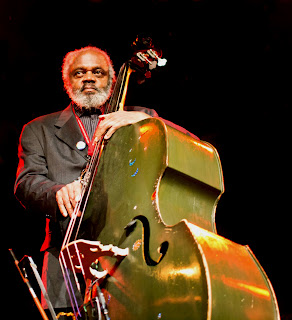Don Cherry:
Symphony for Improvisers from
“Symphony for Improvisers” (1966) [19.44] – Peter Brötzmann, Fred Hopkins,
Rashied Ali: No Messages from
“Songlines” (1994) [12.38] – Sonny Rollins: Summertime
from “Sonny Meets Hawk” (1963) [5.56] – Peter Brötzmann and Keiji Haino:
excerpt from “Evolving Blush or Driving Original Sin” (1997) [10.15] – Marc
Ribot Spiritual Unity: Spirits (live
broadcast) [9.14] – Peter Brötzmann: Tell
a Green Man from “Nipples” (1969) [15.32] – Henry Grimes Trio: Flowers for Albert from “Live at the
Kerava Jazz Festival” (2004) [7.48]
Henry Grimes (born November 3, 1935, Philadelphia , Pennsylvania
Gradually
growing interested in free jazz, Grimes performed with most of the music's
important names, including pianist Cecil Taylor, trumpeter Don Cherry,
saxophonists Steve Lacy, Pharoah Sanders, Archie Shepp, and Albert Ayler. He
released one album, The Call as a trio leader for the ESP-Disk record label in
1965.
In the late
1960s, Grimes career came to a halt after his move to California Los Angeles , California New York to Los Angeles
Peter Brötzmann (born 6 March 1941) is a German artist and
free jazz saxophonist and clarinetist.
Brötzmann
is among the most important European free jazz musicians. His rough timbre is
easily recognized on his many recordings. He studied painting in Wuppertal Wuppertal
For Adolphe
Sax, Brötzmann's first recording, was released in 1967 and featured Kowald and
drummer Sven-Åke Johansson.
1968, the
year of political turmoil in Europe , saw the
release of Machine Gun, an octet recording often listed among the most notable
free jazz albums. Originally the LP was self-produced (under his own
"BRO" record label imprint) and sold at gigs, but it was later
marketed by Free Music Production (FMP), In 2007, Chicago-based Atavistic
Records reissued the Machine Gun recording.
The album Nipples was recorded in 1969 with many of the Machine Gun musicians including drummer Han Bennink, pianist Fred Van Hove and tenor saxophonist Evan Parker, plus British free-improv guitarist Derek Bailey. The second set of takes from these sessions, appropriately called More Nipples, is more raucous. Fuck De Boere (Dedicated to Johnny Dyani) is a live album of free sessions from these early years, containing two long improvisations, a 1968 recording of "Machine Gun" live (earlier than the studio version) and a longer jam from 1970.
The
logistical difficulties of touring with an octet resulted in Brötzmann
eventually slimming the group to a trio with Han Bennink and Fred Van Hove.
Larger groups were put together again later, for example in 1981 Brötzmann made
a radio broadcast with Frank Wright and Willem Breuker (saxes), Toshinori Kondo
(trumpet), Hannes Bauer and Alan Tomlinson (trombones), Alexander von
Schlippenbach (piano), Louis Moholo (drums), Harry Miller (bass). This was
released as the album Alarm. In the 1980s, Brötzmann flirted with heavy metal
and noise rock, including a stint in Last Exit and subsequent recordings with
Last Exit's bass guitarist and producer Bill Laswell.
Brötzmann
has remained active, touring and recording regularly. He has released over
fifty albums as a bandleader, and has appeared on dozens more. His "Die
Like A Dog Quartet" (with Toshinori Kondo, William Parker and drummer
Hamid Drake) is loosely inspired by saxophonist Albert Ayler, a prime influence
on Brötzmann's music. Since 1997 he has toured and recorded regularly with the
Peter Brötzmann Chicago Tentet (initially an Octet).
To listen to the podcast, go to Podomatic website and search for 'completecommunion'.
To send me material to be featured on the podcast, email me at galasi.g [at] virgilio.it or gianpaolo.galasi [at] gmail.com



No comments:
Post a Comment